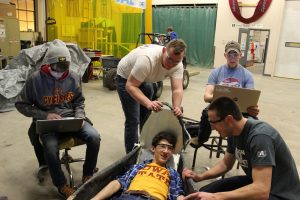
When most of us drive our cars, we’re busy thinking about what’s on the radio, what we’re making for dinner and, hopefully, the other drivers and pedestrians around us. Most likely, we aren’t thinking about the elaborate computer systems keeping our vehicles running smoothly and safely. And thankfully, we don’t have to think about the computers, because they do their jobs well enough that we don’t notice. But some students at Iowa State University take great interest in the systems running vehicles behind the scenes.
SAE International, or the Society of Automobile Engineers, was started in 1905 in New York City in response to a growing demand: Automobile manufacturing was on the rise, and engineers wanted and needed a resource for communicating knowledge and expertise, as well as sharing ideas about and solutions to technical issues. As technology progressed, electronics and computers became increasingly important to the automobile industry, and SAE changed with the times.
Flash forward 112 years later to Ames, Iowa, where SAE International is a thriving student organization on Iowa State’s campus, with 418 total collegiate clubs and branches around the world. At ISU, SAE International is comprised of five teams of approximately 320 students working on designing and building different vehicles, including cars, snowmobiles and airplanes. Their mission is “to expand upon the ISU classroom education through participation, leadership, outreach, design and fabrication,” and the club members spend many nights and weekends together to achieve this goal and to win competitions across the country and even around the world.
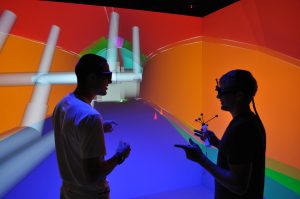
Within these five teams, Formula, Baja, Supermileage, Clean Snowmobile and Aero, students use electronics and computer systems to improve the speed, safety and efficiency of the vehicles. SAE puts no requirements on academic majors of their members, though many come from the College of Engineering, and some are future electrical, computer and software engineers.
One of those students, Mitchell Kerr, a junior software engineering major, is Project Director for Supermileage, whose members design and build a fuel-efficient vehicle and make it as aerodynamic and lightweight as possible with a goal of achieving 200 miles per gallon.
“Unlike many other clubs, we have built our car completely on our own with almost no outsourcing [help from another company],” Kerr said. “I enjoy problem solving, and with a ground-up build process, there is a lot of that.”
The challenge of building an extremely fuel-efficient vehicle is what led senior mechanical engineering major Ian Baumgartner to start ISU’s Supermileage chapter two years ago when he and a few friends, who later became club members, were just sophomores.
“We started researching [other Supermileage chapters across the country], and the amount of miles per gallon that these cars were getting was absolutely crazy,” Baumgartner said. “Some of the better teams are getting 3,000-plus miles per gallon, depending on what type of power train they’re using, whether it’s electric or gasoline. The electric ones are getting up to 10,000 miles per gallon equivalent. That absolutely blew our mind.”
Because SAE International allows students from any major to join, Baumgartner knew he would need students with different skills. Just like the original founders of SAE in 1905, he wanted to build a place for students to communicate expertise and new ideas.
“The greatest part is the shared collective knowledge,” he said. “There are people who are really knowledgeable in one area but may not be knowledgeable in another, whereas someone else on the team may be knowledgeable in that one area. And so you’re sharing all this knowledge, and everyone’s learning a lot. I know I’ve taught people SOLIDWORKS as my expertise, and there are other people who are really good with mechanics, and they’ve taught me a lot. There are people who are really good with engines, really good with carbon fiber, and so it’s all just this collective learning about all these different areas.”
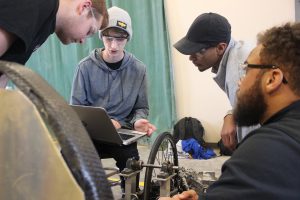
Supermileage members use carbon fiber, which both Kerr and Baumgartner say they knew almost nothing about before joining, to make their vehicle lightweight and as fuel efficient as possible.
“Every ounce you can shave off the car could potentially get you another five miles per gallon. Our car is 10 feet long, 40 inches wide and close to three feet tall. But for a car of that size, it probably only weighs 50 pounds at most, just by itself, so it’s really lightweight,” Baumgartner said. With a driver in the car, the total weight will not pass 200 pounds.
Originally, members worked with pre-impregnated carbon fiber, which uses a hardener and resin to bond and create a hard surface. But to achieve that hardness, students had to lay the fiber in multiple directions and then apply heat to the vehicle’s shell.
The problem? Baking a ten-foot-long car in one shot.
“We actually had to build our own oven,” Baumgartner said. “It was four feet by 12 feet to fit the whole entire car in, because we couldn’t find a place that had an oven large enough. We used foam installation plywood. I know it’s crazy to make an oven out of wood, but the combustion temperature of wood is 460 degrees, and we didn’t need it to get that high. So we actually tore up a microwave oven and used the heating element for that and an old computer fan with some ducting to blow the air around. We were able to get the oven up to 150 degrees and get the car into there and bake it.”
Besides having the ability to work with carbon fiber and build an oven from scratch, other technical knowledge required to build Supermileage’s vehicle includes working with an EFI kit, or Electronic Fuel Injection kit, as well as the team’s use of augmented reality.
“We use an EFI kit, which uses a computer that has software to determine the best air-to-fuel ratio for the engine,” Kerr said. “It has sensors for temperature, pressure, O2 and so on.”
Baumgartner echoed Kerr’s thoughts on benefits of using the kit.
“The EFI kit will definitely help us get a lot better fuel mileage because we’re able to actually control the fuel in and out more precisely. We’re able to tune the engine now a lot quicker with a laptop versus having to adjust the throttle body,” he said. “We have actually thought about having a small Raspberry Pi computer and having it continuously tune the engine as the car’s running, so to adjust the air-to-fuel ratio mixture.”
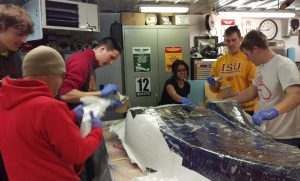
Baumgartner also got the idea to use augmented reality to help design and build the vehicle after taking a course with Mechanical Engineering Professor Judy Vance.
“The big problem with designing in CAD [computer-aided design] is that you can’t really tell the scale of the car in real life. You’re just stuck with this 3D image transformed onto a 2D plane. And you do have these set lengths and distances that you’re dealing with, but you don’t get a good idea about depth perception, and the size perception is really skewed,” Baumgartner said.
Vance allowed students taking her course to look at their own 3D CAD models in the Multimodal Experience Testbed and Laboratory (METal) in the Black Engineering building, which houses the Department of Mechanical Engineering. METal is a three-projection screen immersive room, which supports development of products and processes through computer-based simulation. Baumgartner worked with a graduate student to program their car into augmented reality.
“We were able to see it in that one-to-one scale, and it was immensely helpful,” he said. “We actually had our driver come in and sort of virtual-reality-like sit in the car to see if the window that we had originally designed [on the vehicle] was enough for him to see out through it, and we discovered that it actually wasn’t. So that was a huge thing we were able to discover.”
Baumgartner uses an application on his phone to view a 3D model of the car, which is uploaded to the program. When he points the camera of his phone at a cylinder, recognized by the app, an image of the car appears on the screen of his phone.
“Anyone can do it that has a smartphone,” he said. “Now we don’t have to reserve a time [to work] at a spot. We can just have it on our phone, look at a marker and then see the car there. It’s way more applicable and easy to use for everyone.”
This ingenuity makes Supermileage successful, which in turn will help these students be successful in their futures.
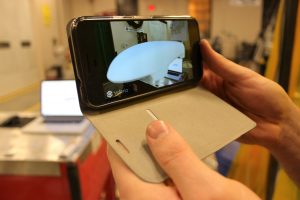
“My dream job is to work in the automobile industry as a software engineer, helping to progress the industry toward more automation, higher safety ratings and cleaner energy consumption,” Kerr said. “Supermileage will help me in my future because I’ve learned how to tackle problems that I have little to no background in. I do this by reaching out to people more knowledgeable than me, conducting my own research, brainstorming with team members and testing ideas.”
This is where being not just club members but teammates comes in – these students get more out of their SAE International memberships than experience on a resume.
“We’re almost like a family by the time the year’s done,” said Jason Whited, president of SAE International and mechanical engineering senior. “The leaders and all the core members that stick around through the entire year really learn a lot about each other and learn how to work together a lot more, so it’s a more personal experience than just being in a very, very large organization where everybody’s doing the same thing. [In SAE International], everybody has their goals and their own jobs, and you work together to accomplish that. That’s a lot more unique in terms of a college experience.”
While being in SAE requires long hours and lots of hard work, members say making the most of that time is beneficial.
“You become invested if you put the time into it,” Whited said. “You have very strong feelings about building this car. You become attached to it in a different way than just designing something on SOLIDWORKS in your free time. Because now, you’re involved in a whole group of people building this together.”